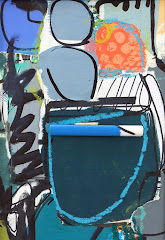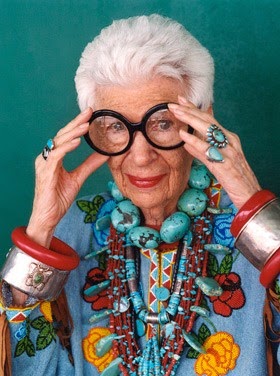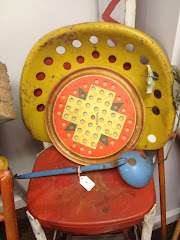Shabby Garden
Cottage gardens associated with the English countryside are known for their colorful, informal, relaxed landscape and surroundings.

Today many cottage style collectors are after a more folksy look and hunt for garden collectibles and accessories which are charming, practical and perhaps a bit quirky. Found objects which are rusty, flaky, crackled, worn, chipped and weathered are preferred over newer manufactured items.
Creative Ideas to Use for Dish Gardens and Planters
Once you start playing with ideas, it is actually quite easy to find a great deal of objects which can be used as planters, flower boxes and outdoor decorative items. For example, old kettles, wood soda crates, old wash tubs

, oversized ceramic bowls are all wonderful basins or containers for plants and flowers.
"Orphaned" Kitchen Collectibles Make Great Planters
Because cottage style is all about re-cycling and re-purposing what you have look around your kitchen and in your storage areas for "orphaned" kitchen and house-wares which can be put to use in your sunroom, on your deck or patio. An enamelware coffee pot that has lost its top looks adorable with a hanging plant. Pyrex casseroles make sweet bases for "dish garden". Photo (L) Courtesy of Vintagepastelle.com
Color and pattern is a fun way to organize collections. Reds (geraniums) go well with green, turquoise, yellow accessories etc. Roses look gorgeous in hand painted floral themed china vases or tea cups. Pastel planters spring to life with soft cottage color flowers.

During the post-war years (late 1940s-1950s) flower themed home accessories were everywhere and today many people like to use these decorative objects in their home, porch and sunroom areas. Vintage kitchen accessories, glassware, storage items, curtains, drapes, pillows, tablecloths with bold colorful flower patterns can add a whimsical funky look to todays decor.
Softer Cottage Style Colors
In contrast to bold colors, many romantic cottage collectors prefer whites and pastels in and around their gardens or home interiors. Pinks, aqua's and soft greens, yellows and peach, referred to as sometimes "cottage colors" and can provide a lighter softer look. You will often see these palettes in homes inside and outside in beach communities. A cut down old picket fence (backing) and some scrap wood (seat or shelf) can be assembled and painted pink or turquoise and used as a charming bench or display for plants.
Whether your tastes are for primary colors, pastels or patriotic red, white and blue, you can have a lot of fun in and around your garden.
Other popular garden collectibles are garden tools, birdhouses, folk art, furniture, watering cans, garden signs, planters, ornaments etc. Many of these items can easily be found at tag sales, flea markets and second hand shops.
 Finding Garden Collectibles at Tag Sales
Finding Garden Collectibles at Tag Sales
When you visit a tag sale and you do not see garden collectibles for sale, don't be afraid to inquire if the owner has some goodies hiding in their garage or tool shed that they are willing to part with. Many homeowners aren't aware that there is actually interest in old rusty hand tools, older terracotta pots, vintage hand tools, flaky picket fences etc. Pick neighborhoods with very old homes when you are out and about "junking" for garden tools and collectibles. My motto here is that "Thar's Gold in Them Thar Garden Sheds" ....well maybe not gold...but a lot of groovy, aged rusty garden and outdoor treasures.
Reproduction Garden Accessories
Reproductions:Reproduction vintage style garden accessories are plentiful. These objects are made so well.. it's real easy to get fooled. Shop around, ask questions, get to learn which items are commonly reproduced such as sap buckets, gates, statues etc. You can learn a great deal from shops that carry both new and vintage garden accessories by asking the owner or staff to show you some differences between new and old objects. While often a lower price marked on an item that generally yields more is a clue to a seasoned shopper that what they are looking at may not be an original, this is only a starting point. The beginner generally doesn't know what prices to expect which is why a review of the collectibles shown in this section is a helpful beginning. And you may get lucky, you may find some bargains that are priced reasonably and are in fact the real deal.
Photos Courtesy of The Bleu Willow, Simsbury, CT
C. Dianne Zweig is the author of Hot Kitchen & Home Collectibles of the 30s, 40s, 50s and Hot Cottage Collectibles for Vintage Style Homes. She is also the Editor of Iantiqueonline.com an actively growing internet based resource community for people who buy, sell or collect antiques, collectibles and art. You can find Dianne’s fabulous retro and vintage kitchen, home and cottage collectibles at The Collinsville Antiques Company of New Hartford, CT, a 22,000 feet antique emporium with an in-house retro café.
To read more articles by C. Dianne Zweig click on this link:
C. Dianne Zweig’s Blog Kitsch ‘n Stuff Email me at
dianne@cdiannezweig.comVisit my website,
CDianneZweig.comDianne is a member of:
The American Society of Journalists and Authors
The Authors Guild, Inc.
 It has been over thirty years since I visited Port Jefferson, a charming village located approximately 56 miles east of New York City, in the northern part of central Suffolk County. I was pleasantly surprised to discover that this tree lined seaside artsy community was alive and well with eateries, boutiques, galleries and historic buildings.
It has been over thirty years since I visited Port Jefferson, a charming village located approximately 56 miles east of New York City, in the northern part of central Suffolk County. I was pleasantly surprised to discover that this tree lined seaside artsy community was alive and well with eateries, boutiques, galleries and historic buildings.  in St.) a classy yet quirky home gift shop with an eye catching purple painted vintage Hoosier Cabinet in one window and a fab cream and green enamel stove in the opposite window. Let me tell you that when I spotted “Grapes” from across the street, my retro nerve center was lighting up like the Manhattan electric grid that covers Times Square.
in St.) a classy yet quirky home gift shop with an eye catching purple painted vintage Hoosier Cabinet in one window and a fab cream and green enamel stove in the opposite window. Let me tell you that when I spotted “Grapes” from across the street, my retro nerve center was lighting up like the Manhattan electric grid that covers Times Square.  -vintage zone. Before I go any further, I want to be clear, this was not an antique shop, but it certainly had great “old stuff”. Perhaps one might describe “Grapes” as a charming shop that is styled with a “Metro Retro” or “Fresh Vintage” flair. Whatever you want to call “the look”, this trendy boutique combines country with urban ; forties with contemporary and mid-century with cottage cr
-vintage zone. Before I go any further, I want to be clear, this was not an antique shop, but it certainly had great “old stuff”. Perhaps one might describe “Grapes” as a charming shop that is styled with a “Metro Retro” or “Fresh Vintage” flair. Whatever you want to call “the look”, this trendy boutique combines country with urban ; forties with contemporary and mid-century with cottage cr eating a whole new take on home décor and entertaining.
eating a whole new take on home décor and entertaining.  C. Dianne Zweig is the author of Hot Kitchen & Home Collectibles of the 30s, 40s, 50s and Hot Cottage Collectibles for Vintage Style Homes. She is also the Editor of Iantiqueonline.com an actively growing internet based resource community for people who buy, sell or collect antiques, collectibles and art. You can find Dianne’s fabulous retro and vintage kitchen, home and cottage collectibles at The Collinsville Antiques Company of New Hartford, CT, a 22,000 feet antique emporium with an in-house retro café.
C. Dianne Zweig is the author of Hot Kitchen & Home Collectibles of the 30s, 40s, 50s and Hot Cottage Collectibles for Vintage Style Homes. She is also the Editor of Iantiqueonline.com an actively growing internet based resource community for people who buy, sell or collect antiques, collectibles and art. You can find Dianne’s fabulous retro and vintage kitchen, home and cottage collectibles at The Collinsville Antiques Company of New Hartford, CT, a 22,000 feet antique emporium with an in-house retro café.











 ottage style", "decoating with antiques and collectibles". "1950's kitchen and bath collectibles"
ottage style", "decoating with antiques and collectibles". "1950's kitchen and bath collectibles"















.JPG)












